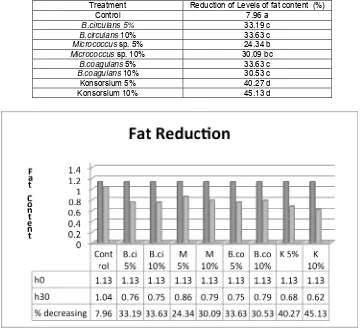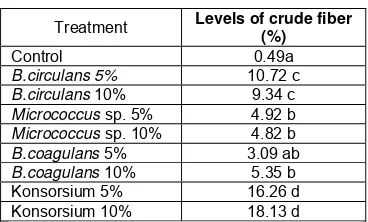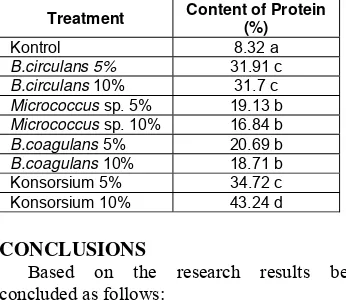THE INFLUENCE OF FERMENTATION BY Bacillus
circulans, Micrococcus sp., AND B.coagulans TOWARDS FAT,
CRUDE FIBER, AND PROTEIN CONTENT OF PALM OIL
EMPTY FRUIT BUNCHES WASTE (Elaeis guineensis Jacq.)
Ratu Safitri
1*1
University of Padjadjaran, Indonesia
Abstract
The purpose of the research is to get an efective isolates and inoculum consentration for decreasing fat and crude fiber, also increasing protein content in palm oil empty fruit bunches waste fermentation. It’s using an experimental methods with Complete Randomize Design (CRD) with 2 factors and 3 replication. First factor were Consortium of bacteria (B) they were: (b1)
Bacillus circulans, (b2) Micrococcus sp., (b3) B.coagulans, and (B4) B.circulans, Micrococcus sp.,
and B. coagulans consortium. Second factor were inoculum concentration (K): (k1) 0%, (k2) 5%,
and (k3) 10%. Observed parameter were fat (Soxhlet Methods), crude fiber (Hidrolysis Methods),
and protein (Kjeldahl Methods). Result of research data were analyzed using analysis of variance followed by multiple range Duncan test. The result showed that inoculation of 5% B.circulans, Micrococcus sp., dan B.coagulans consortium efective for decreasing 40.27% fat and 16.26% crude fiber. 10% of B.circulans, Micrococcus sp., dan B.coagulans consortium, effective for increasing 43.24% protein after 30 days of fermentation processed.
Key words: Crude fiber, Lignocellulolytic bacteria, fat, fermentation, Protein
INTRODUCTION1
Fermentation of feed ingredients is one way to improve the nutritional quality of feed is lowered fat content, reducing the crude fiber content and increasing the protein content by using the appropriate microorganisms and excel. In fermentation, microorganisms synthesize enzymes that can degrade the polymer into the substrate into simpler molecules, making them easier to digest . Fermented food products will have high quality such as high levels of digestibility and flavor and better texture.
Crude fiber components that can not be digested by animals are cellulose; hemicellulose and lignin that microorganisms needed to transform these components into simpler components. Lignocellulose is the largest component that has not been used to its full potential because it is very complex. This material is widely available in industrial
*Corresponding author: [email protected] The manuscript was received: 13.07.2014
estates, such as palm oil industry. Oil palm empty fruit bunches (TKKS) is one type of solid waste generated in the palm oil industry. TKKS components of the waste consists of lignin 17.2%, 42.7% cellulose, and hemicellulose 27.3% (Darnoko et al., 1993) [1]. Total waste palm oil in Indonesia reached 15.2 million tons of solid waste (TKKS)/year (Mahajoeno, 2010) [2]. In order TKKS waste is not causing problems, it needs good waste management to manage it, so it can be used as animal feed by reducing the fiber content
Fermentation of lignocellulosic materials can use lignoselulolitik microorganisms, because the bacteria produce ligninase and cellulase enzymes that function to degrade lignocellulose. Cellulolytic bacteria can be isolated from TKKS substrates containing lignin, cellulose, and hemicellulose, breakdown the organic materials through enzymatic reactions produce simpler compounds.
known to degrade lignin, cellulose, and hemicellulose. According Suhardi (2010) [3],
B. circulans produce cellulase enzymes with high activity and can hydrolyze starch, produces the enzyme β-galactosidase, produces acid from glucose, L-arabinose, cellobiose, fructose, galactose, methyl beta-xylosida, sucrose, and D –xylose.
Micrococcus sp. can be isolated from sewage TKKS, a lignoselulolitik bacteria, also able to reduce nitrate levels and the use of organic sources of nutrients as a source of carbon that acts as degrading organic matter (Tesia and Dayu, 2010). Other than that
Micrococcus sp. can also degrade lignin content in the leachate (Yupitasari, 2011).
B.coagulans are also electrically insulated from TKKS waste, producing cellulase enzymes, also known to degrade lignocellulosic bagasse, corn stover, rice husks, sawdust and coconut fiber. It also hydrolyzes starch, and form acid from glucose, glycerol, fructose, and galactose melibiosa. There are also some species that can reduce nitrate to nitrite. These bacteria belong to the genus Bacillus which produces lactic acid which is commonly used as probiotics in animal feed.
TKKS waste fermentation process naturally requires considerable time, and the length of time required in the process will cause problems, therefore fermented by bacteria and proper inoculum may expedite appropriate in order to reduce the content of fat, crude fiber, and can improve protein in TKKS waste so that waste can be utilized further into animal feed. The purpose of this study was to determine the ability of indigenous bacteria B.circulans, Micrococcus sp., and B.coagulans at inoculum concentrations of 0%, 5%, and 10% were single and consortium in TKKS fermentation for 30 days to improve the quality of the substrate TKKS order can then be used as animal feed raw materials.
MATERIAL AND METHODS
Materials
Materials used in this study, among other things: Waste TKKS obtained from
plantations and palm oil mills in Garut Regional, bacterial culture B.circulans, Micrococcus sp., and B.coagulans wild-type, Nutrient Agar (NA) OXOID ®, Nutrient broth (NB) OXOID ®, biochemical test medium, IMViC, Semi Solid medium, medium TSIA, urea medium; nefelometer McFarland; bacterial dyes and other chemicals for the determination of fat content, protein content and crude fiber content.
Method
This research was conducted with completely randomized design (CRD) with two-factor factorial with three replications. The first factor is the type of bacteria (B) to the extent: (b1) B.circulans, (b2) Micrococcus sp., (b3) B.coagulans, and (b4) consortium B. circulans, Micrococcussp., and B.coagulans. The second factor is the concentration of inoculum (K) consists of three levels, namely 0% control (k1), 5% (k2), and 10% (k3). Observations were then analyzed by analysis of variance (ANOVA). If the results are real then it would be followed by Duncan's Multiple Range Test at 5% significance level (Gomez & Gomez, 1995) [6]. The observed parameters which include crude fat content was analyzed by the Soxhlet method (AOAC, 1980) [7], protein content was analyzed by the Kjeldahl method (AOAC, 1980) and crude fiber content was analyzed by hydrolysis method (AOAC, 1980)[7].
RESULTS AND DISCUSSIONS
Levels of Fat Content
Based on the fat content measurement results, obtained 1.13% early before fermentation. Decreased levels of fat in each treatment after can be seen in the following diagram (fig. 1). Based on the diagram is known that treatment of bacterial consortium
B.circulans, Micrococcus sp., and B.coagulans
concentration of 10% resulted in a decrease in the highest fat content of 1.13% to 0.62%.
Table 1 The results of Duncan's multiple range test Interactions between bacteria type and level of fat
Treatment Reduction of Levels of fat content (%)
Control 7.96 a
B.circulans 5% 33.19 c
B.circulans 10% 33.63 c
Micrococcus sp.5% 24.34 b
Micrococcus sp. 10% 30.09 bc
B.coagulans 5% 33.63 c
B.coagulans 10% 30.53 c
Konsorsium 5% 40.27 d
Konsorsium 10% 45.13 d
Description: B.ci: B.circulans; M: Micrococcus sp.; B.co: B.coagulans; K: Consortium
Figure 1 Decrease of fat during fermentation
Based on the content of fat is known that there is no difference between the fat content of fermented inoculum concentration of 5% and 10%, but the consortium B. circulans,
Micrococcus sp., and B. coagulans at either inoculum concentration of 5%, and 10% decrease compared to the content of the decline levels of fat in a single fermentation. So it can be said that the use of consortia of bacteria on fermentation TKKS more effective in lowering fat levels in the effluent TKKS.
According to Howard et al., (2003) [8], the decomposition of waste using microorganisms consortium agent is more
efficient than a single treatment microorganisms, since the combined consortium of microorganisms produce various enzymes of microorganisms activity so that more waste can be degraded.
Levels of Crude Fiber Content
Note : B.ci: B.circulans; M: Micrococcus sp.; B.co: B.coagulans; K: Consortium
Figure 2 Reduction of Crude Fiber during fermentation
Based on Figure 2, it can be seen that the decrease in crude fiber content was highest in the fermentation by a consortium
B.circulans, Micrococcus sp., and B. coagulans with inoculum concentrations ie 10% of the initial crude fiber content of 37.17% to 30.43%. Based on the analysis of variance known during fermentation there was an interaction between the type of bacteria to the concentration of the inoculum to the percentage decrease in crude fiber content (Table 2).
Table 2 The results of Duncan's multiple range test Interactions between bacteria type and concentration of inoculum against the percentage reduction in crude fiber content
Treatment Levels of crude fiber
(%)
Control 0.49a
B.circulans 5% 10.72 c
B.circulans 10% 9.34 c
Micrococcus sp.5% 4.92 b
Micrococcus sp. 10% 4.82 b
B.coagulans 5% 3.09 ab
B.coagulans 10% 5.35 b
Konsorsium 5% 16.26 d
Konsorsium 10% 18.13 d
Based on the table 2, is known that the consortium B.circulans, Micrococcus sp., and
B. coagulans concentration of 5% and 10%
resulted in a decrease in the percentage of crude fiber content is no different. It can be concluded that the use of a consortium of more effective concentration of 5% is used to lower crude fiber content TKKS waste.
Content of Protein
Based on the results of early measurements, the protein content before the start of the fermentation process is 4.81%. The increasing percentage in protein content after fermentation for 30 days (Fig. 3). Based on Figure 3. note that the Consortium B. circulans, Micrococcus sp., and B. coagulans
produce the highest protein levels of 4.81% to 6.89%. This suggests that the three types of bacteria that can interact synergistically to produce proteins. Based on the results of Duncan's multiple range test known there was an interaction between the type and concentration of bacterial inoculum to the percentage increase in protein content in the waste TKKS (Table 3).
From the results of Duncan's multiple range test is known that the consortium
B.circulans, Micrococcus sp., and
Note : B.ci: B.circulans; M: Micrococcus sp.; B.co: B.coagulans; K: Consortium Figure 3 Increase of Protein during fermentation
Table 3 The results of Duncan's multiple range test interaction type and concentration of bacterial inoculum to the percentage increase in protein content
Treatment Content of Protein
(%)
Kontrol 8.32 a
B.circulans 5% 31.91 c
B.circulans 10% 31.7 c
Micrococcus sp.5% 19.13 b
Micrococcus sp. 10% 16.84 b
B.coagulans 5% 20.69 b
B.coagulans 10% 18.71 b
Konsorsium 5% 34.72 c
Konsorsium 10% 43.24 d
CONCLUSIONS
Based on the research results be concluded as follows:
1. Inoculum concentration of 5% by a consortium B. circulans, Micrococcus sp., and B. coagulans can decrease the fat content of 40.27% and a decrease of 16.26% crude fiber in the waste fermentation process TKKS for 30 days.
2. Inoculum concentration of 10% by a consortium B. circulans, Micrococcus sp., and
B.coagulans concentration of 10% were able to increase the protein content of 43.24% TKKS waste after fermentation for 30 days.
3. TKKS waste fermentation inoculated by the consortium to reduce the levels of crude
fiber, reduce fat and increase the protein compared to the singly inoculated fermentation.
REFERENCES
[1] Darnoko, Z. Poeloengan & Iswadi,A. 1993.
Pembuatan Pupuk Organik Dari Tandan Kosong Kelapa Sawit. Buletin Penelitian Kelapa Sawit, 2, 89-99.
[2] Mahajoeno, E. 2010. Limbah Pabrik Kelapa Sawit Dibuat untuk Energi
Terbarukan.http://www.alpensteel.com/article/53-101-energi-terbarukanrenewable-energy/3076. Diakses tanggal 25 Januari 2012
[3] Suhardi, W. 2010. Isolasi dan Karakterisasi
Ekstrak Kasar Sistem Selulase dari Bacillus circulans Strain Local. Skripsi. Jurusan Kimia.
[4] Tesia, A., D. Dayu. 2010. Peranan Mikroba
Dalam Pengolahan Limbah Lingkungan. Jurusan Biologi FMIPA. Universitas Negri Malang. Malang.
[5] Yupitasari, Eva. 2011. Isolasi dan Uji Kemauan
Bakteri Asal Air Lindi dalam Mendegradasi Air Lindi Awal (Inlet). Skripsi. Jurusan Biologi Unpad. Jatinangor.
[6] Gomez & Gomez. 1995. Prosedur Statistik
untuk Penelitian Pertanian. Penerbit Universitas Indonesia. Jakarta.
[7] AOAC (Association of Analytical Communities).
1980. Official Method of Analysis. 13rd rev. ed.
Association of Official Chemists
[8] Howard R.L., P. Masoko and E. Abotsi. 2003.
Enzime Activity of Phanerochaete chrysosporium Cellobiohydrolase (CBHI.1) Expressed as a Heterologous Protein From Escherichia coli.


